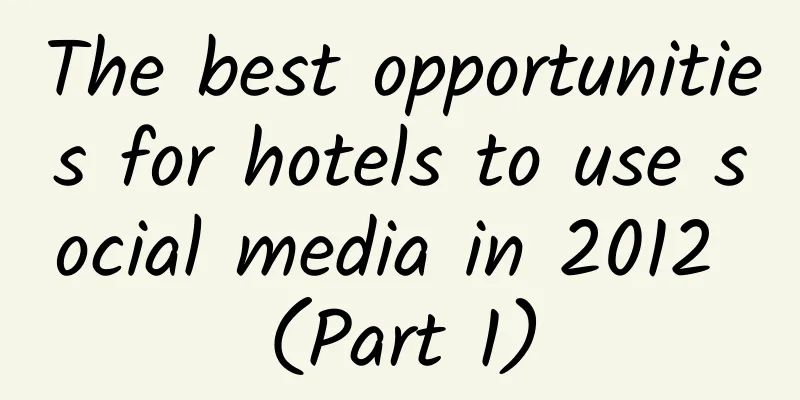The best opportunities for hotels to use social media in 2012 (Part 1)

|
Niels Bohr once said: “Prediction is difficult, especially predicting the future.” In this series of posts, I want to take a slightly different approach and instead of looking back at the technologies that I think have had the biggest impact on the hospitality industry over the past year, I hope to use this as a source of inspiration as we look forward to the year of innovation ahead. Understanding whether a technology is relevant to your readers and whether it can help you is often more valuable than trying to determine whether it will be the next major global trend. Now let’s look at some of the interesting things that happened in travel tech over the past year that I think are interesting, and think about whether they might be helpful to your situation. Social networks have become more personal, with the emergence of selective content sharing (and consumption) It should have been like this a long time ago. Those vacation photos you wanted to share with your party goers might not be for everyone to see. Because people have different preferences for sharing aspects of their lives with family, friends, colleagues, and customers, social networks need to have multiple levels of privacy. As Dave Taylor wrote in the Huffington Post: "Whether we are young or married with children, we belong to different social, cultural and political groups, and we are different from our friends." "You know what I'm talking about is the 'intensity' or 'depth' of relationships. It's complicated, especially when you realize that relationships are not symmetrical because you can consider someone your best friend even though they only consider you a good friend, not a close friend." Over the last year, the tools for sharing people's lives with select groups on social networks have become increasingly advanced and important. In 2011, social networks have finally begun to recognize individual privacy preferences beyond the two options of private and public. First, Google Plus launched Circles, which offered a form of selective sharing of content. Facebook soon followed suit with advanced content sharing options, perhaps an even more important signal for travel companies, as people can ignore people and brands that are not relevant to them. This growth in social networks means people now have more control over what they see and what information they receive, making it increasingly important for travel brands to remain interesting and relevant. (And even better if you can get influential and interesting people talking about you online.) Boring content will fade into obscurity. If you are not compelling, you are better off not participating. So, how do you become more interesting? Learn from the people who publish the most interesting and engaging content online. Marc Schiller, CEO of Bond Strategy and the man who has created campaigns for Christina Aguilera and The Economist, among others, told Business Insider: “As a marketer, I focus on behavior rather than technology. We really need to study and adapt to how people behave online — how they present themselves, how they create, how they organize. Then, you have to provide value to that. That’s the key to success.” The same applies to the hospitality and travel industries, where the marketers who publish the most compelling content are always on the lookout for the latest and coolest stuff. Sabine de Witte is a prime example of a hotel that connects closely with the new generation of travelers that high-end hotel brand CitizenM is courting. Today’s digital elites want more than just information about your company; they want to know the latest and coolest news and are particularly interested in the people who create it. "Our readers love the little 'everyday life' stories written by the famous 23-year-old Dutch fashion blogger. Readers don't want superficial information: they want to know more about other people's lives." According to de Witte, today’s marketers must adapt to the lifestyles of the people they wish to communicate with: The Roger Smith Hotel used a similar approach when managing their digital magazine, The Jolly Roger, in New York. Not only did their marketing team, but also their sales director, interns, and general manager provided suggestions on what to do in New York. The result: a real New York City viewed by a real New Yorker—a great example you can use in your own company. And that leads us to another big thing I saw… The entire company is involved in social marketing This also happens naturally as employees’ expertise is also tapped into to create more interesting social media content. As mentioned above, Roger Smith’s team did a great job of this because they intentionally hired the right people and involved them in the content publishing process. There are all sorts of ways to get your employees involved in social marketing. Simple methods include featuring team members – like the Mandarin Oriental Hotel Group does by highlighting individual staff members on its Hong Kong hotel Facebook pages. You can also choose a more proactive approach and involve individual employees in creating content. For example, your concierge team has a wealth of local knowledge and tips that can be used to create engaging digital content, whether that’s shared via a blog, YouTube, Twitter or Foursquare. Mobile photo sharing goes mainstream Design-driven companies are rapidly adopting mobile photo-sharing sites like Instagram, which embody three major trends in marketing today: social, mobile, and local. Hotel groups like CitizenM and Morgans share not only the latest information about their hotels, but also beautiful photos of their surroundings. These photos are often a new form of commentary for consumers. People use these sites to inspire and express their creativity, so the content is almost always positive. Social networks with unique user targeting become valuable brand marketing tools Continuing the above trends, unique social networks such as Pinterest are showing their importance in building brands and connecting with niche audiences. By curating this cool content, it becomes possible to communicate a lifestyle message that is very important for many brands in the hospitality industry. Moreover, it is also a great way to feel new trends and influence some of them. “Think of our site as a virtual pinboard,” the Pinterest team said. Heather Allard explains the opportunity well: “If you had the opportunity to make your business part of someone else’s dream board, would you do it? Pinterest is that dream board. Think of it as a visual buffet, a beautiful book that combines all the things we desire in life.” Early adopters such as Gansevoort Hotels have begun experimenting with sharing images on Pinterest. Guestsourcing becomes more important The rise of niche social media networks and the dramatic growth in the production and sharing of content (most of which is images and videos) has created another opportunity. I coined the term guestsourcing in 2009 to describe the trend of hotels using user-generated content in their marketing. But it wasn’t until 2011 that I first saw hotels start to do this well—often taking content from photo-sharing sites and repurposing it on other social networks. InterContinental Hotels shared photos of the hotel from Twitter on its Facebook page: Hotel Indigo has done a great job in guestsourcing by using photos of their hotels on Pinterest that users have shared on Twitter or uploaded. The concept is simple, but more people need to do it. Just keep an eye on social sites, pick up interesting content, and repost it to Facebook, Tumblr, Pinterest, or wherever else - just give credit to the original author. Profiles become more visible and more important on social networks In a world where anyone can become a publisher, services that can confirm the credibility of publisher profiles become more important. Klout is a leader in this space and is working to create the standard for measuring online influence. Using such criteria becomes clearer for everyone, from the hotel group providing the service, to the PR agency confirming who is qualified to spread the message, and the marketer seeking to build a relationship. Closely related to this trend is the fact that people want to know more about the background and details of content publishers so that they can glean relevant information. The past few years have seen a major shift from “the wisdom of the crowd” to “the wisdom of my friends” to “the wisdom of my friends who share my interests.” This is especially important on sites where users submit reviews anonymously: Learn about the reviewer's credibility and history while recognizing similarities between ourselves and the reviewer. People want experts. The importance of trust and authenticity is growing rapidly. As review sites continue to seek ways to increase the credibility of their communities and content, the desire to understand individual reviewer profiles becomes even more important. In the next article, we’ll talk more about the trends in reviews and user-generated content online, and explore what impact they can have on businesses. via: traveldaily |
<<: CNNIC: 2011 China's 29th Internet User Survey Report
Recommend
The efficacy and function of shrimp flower leaves
Shrimp flower leaves are rich in nutritional valu...
Spending tens of thousands of dollars to store umbilical cord blood, can it really save your baby's life at the critical moment?
This article was first published by Hunzhi (WeCha...
The older you get, the more forgetful you become. This is actually because your brain is constantly improving.
Many people think that forgetting is not a good t...
Brain-computer interface technology helps humans realize "mind communication", how far are we from the cyborg world?
After a stroke, brain damage leads to limb paraly...
Revealing the sleeping habits of birds, most birds do not sleep in their nests!
Birds are common animals in our lives. They have ...
The efficacy and function of purple tube grass root
The root of purple tube grass is a kind of tradit...
What does it have to do with becoming ugly? This "chemical factory" in the human body really affects your appearance!
Many netizens wonder if their yellow or gray comp...
Can fried oil really not be reused multiple times? The answer is not what people think
People who like to eat snacks should have seen fr...
What changes have taken place in American leisure tourism after the epidemic?
Data from the U.S. Travel Association predicts th...
The efficacy and function of the iron lantern rabbit ear wind
Glechoma longituba is a kind of traditional Chine...
Effects and functions of cascara
In modern life, everyone is very familiar with va...
Side effects of chicken blood vine
There are some differences in the treatment of di...
The efficacy and function of Yunnan Hydrangea
Although Western medicine and Western drugs are m...
Side effects of wisteria
Maybe everyone has heard the story of wisteria. I...
The efficacy and function of Rhizoma Phytophthora
Rhizoma Coptidis is a medicinal material. If we h...









